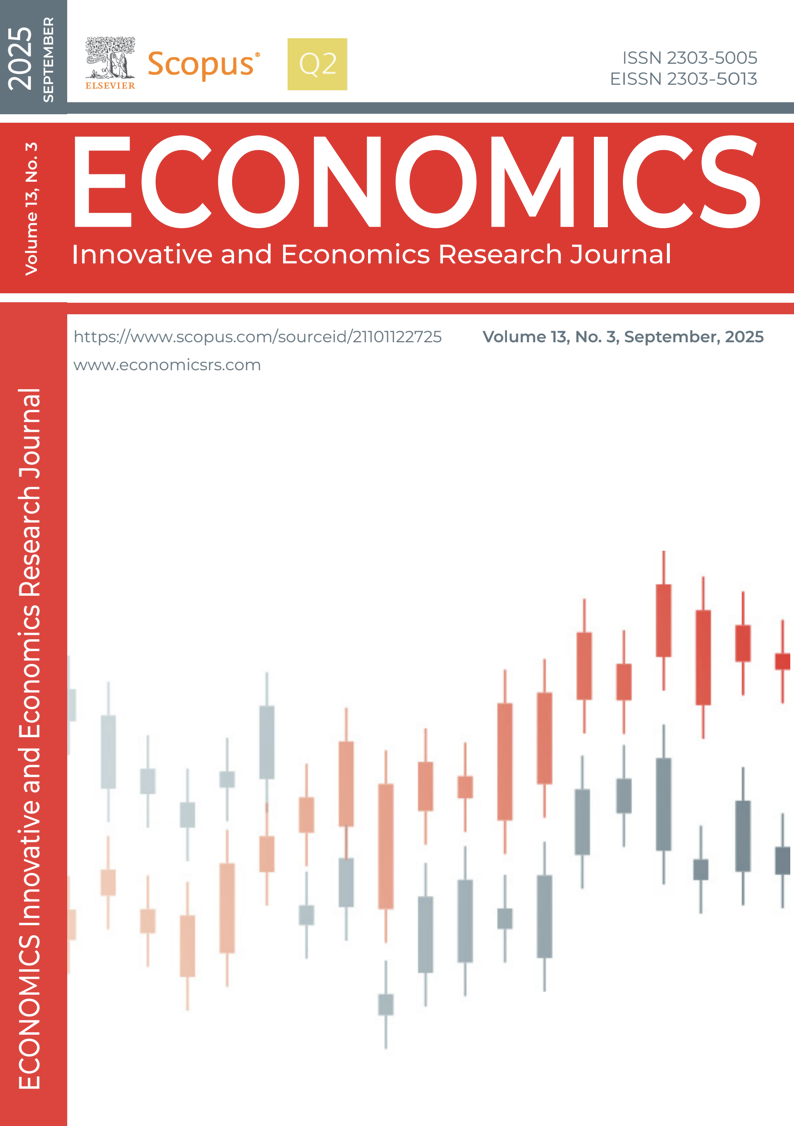THE THRESHOLD EFFECT OF EXCHANGE RATE ON ECONOMIC GROWTH IN BRAZIL, RUSSIA, INDIA, CHINA AND SOUTH AFRICA (BRICS) COUNTRIES
DOI:
https://doi.org/10.2478/eoik-2025-0057Keywords:
exchange rates, economic growth, BRICS, regimes, Panel, Threshold, regressionAbstract
The growth of any economy is pivotal to its development and sustainability. Achieving this kind of feat depends on various factors that include but are not limited to exchange rates. This article examines the threshold effect of exchange rates on economic growth in BRICS countries from 1994 - 2022. The paper employed the Panel Threshold regression model to explore the threshold effect of exchange rates on economic growth in BRICS countries across different regimes (lower regime or upper regime). The findings of this study confirm that economic growth exhibits a positive relationship with exchange rate appreciation in the lower regime (EXCH < 5.164), while exchange rate depreciation in the upper regime (EXCH > 5.164) has a negative impact on growth. Moreover, when the exchange rate depreciates beyond the threshold in the upper regime, the negative effects extend to other control variables such as inflation rate, interest rate and trade openness, further constraining economic growth. These insights provide valuable guidance for BRICS nations and similar economic blocs in formulating more effective monetary and exchange rate policies and choosing the most appropriate exchange rate regime, which can be leveraged by the New Development Bank to enhance economic stability and resilience. This study underscores the significant influence of exchange rates on economic growth in BRICS countries, providing valuable insights for policymakers to refine strategies during excessive exchange rate depreciation. It is one of the few analyses employing the PRT to investigate the threshold effects of exchange rates on growth and the first to do so specifically within the BRICS context
References
Abbasi, G.A. and Iqbal, D.J., (2021). The asymmetric impact of RER-Misalignment on economic
growth: An application of Hodrick–Prescott filter technique. The Singapore Economic Review,
-29. https://dx.doi.org/10.1142/S0217590821500375
Adeniran, J.O., Yusuf, S.A. and Adeyemi, O.A., (2014). The impact of exchange rate fluctuation on the
Nigerian economic growth: An empirical investigation. International Journal of Academic Re-
search in Business and Social Sciences, 4(8), 224. http://dx.doi.org/10.6007/IJARBSS/v4-i8/1091
Adedoyin, L.I., Oluwafunke, A.I., Victor, A. and Asaleye, A., (2016). Exchange rate fluctuation and the
Nigeria economic growth. Euro Economica, 35(2). http://hdl.handle.net/11159/411
Akram, V. and Rath, B.N., (2017). Exchange rate misalignment and economic growth in India. Journal
of Financial Economic Policy, 9(4), 414-434. http://dx.doi.org/10.1108/JFEP-12-2016-0093
Akusta, A. (2024). Comparative Evaluation of Statistical Models and Machine Learning Approaches in
Modelling the Energy Dependency of the BIST Industrial Index: Balancing Predictive Perfor-
mance and Interpretability. Journal of Corporate Governance, Insurance, and Risk Manage-
ment, 11(3), 160-167. https://doi.org/10.56578/jcgirm110302
Aliu, F., Hašková, S. and Bajra, U.Q., (2023). Consequences of Russian invasion on Ukraine: Evidence
from foreign exchange rates. The Journal of Risk Finance, 24(1), 40-58. https://doi.org/10.1108/
JRF-05-2022-0127
Aliyu, S.U.R., (2009). Impact of oil price shock and exchange rate volatility on economic growth in
Nigeria: An empirical investigation. Munich Personal RePEc Archive, MPRA Paper No. 16319,
-15. https://mpra.ub.uni-muenchen.de/16319/
Aman, Q., Ullah, I., Khan, M.I. and Khan, S.U.D., (2013). Linkages between exchange rate and eco-
nomic growth in Pakistan (an econometric approach). European Journal of Law and Econom-
ics, 44(1), 157-164. https://link.springer.com/article/10.1007/s10657-013-9395-y
Ameziane, K. and Benyacoub, B., (2022). Exchange rate volatility effect on economic growth under differ-
ent exchange rate regimes: New evidence from emerging countries using panel CS-ARDL mod-
el. Journal of Risk and Financial Management, 15(11), 499. https://doi.org/10.3390/jrfm15110499
Anyanwu, F., Ananwude, A. and Okoye, N., (2017). Exchange rate policy and Nigeria’s economic growth:
A Granger causality impact assessment. International Journal of Applied Economics, Finance
and Accounting, 1(1), 1-13. https://papers.ssrn.com/sol3/papers.cfm?abstract_id=2945392
Asea, P.K. and Corden, W.M., (1994). The Balassa‐Samuelson Model: An Overview. Review
of International Economics, 2(3), 191-200. https://econpapers.repec.org/RePEc:bla:re-
viec:v:2:y:1994:i:3:p:191-200
Babu Rao, G., (2019). Exchange rate regimes and its impact on growth: An empirical analysis of BRICS
countries. Theoretical and Applied Economics, 26(2), 157-172. https://www.ebsco.ectap.ro/
Theoretical_&_Applied_Economics_2019_Summer.pdf#page=157
Balassa, B., (1964). The purchasing-power parity doctrine: A reappraisal. Journal of Political Economy,
(6), 584-596. https://www.jstor.org/stable/1829464
Barguellil, A., (2021). The asymmetric indirect impact of real exchange rate on economic growth
through foreign trade: An asymmetric ARDL panel model. Asian Economic and Financial Re-
view, 11(8), 658. http://www.aessweb.com/
Barguellil, A., Ben-Salha, O. and Zmami, M., (2018). Exchange rate volatility and economic growth. Jour-
nal of Economic Integration, 33(2), 1302-1336. https://www.jstor.org/stable/10.2307/26431809
Bishop, M., (2022). The BRICS countries: Where next and what impact on the global economy? Eco-
nomics Observatory. https://www.economicsobservatory.com/the-brics-countries-where-next-
and-what-impact-on-the-global-economy
Carletti, E., Claessens, S., Fatás, A. and Vives, X. (2020). Post-Covid-19 World. London: Centre for
Economic Policy Research. http://www.cepr.org/
Caselli, F.G. and Roitman, A., (2019). Nonlinear exchange‐rate pass‐through in emerging markets. In-
ternational Finance, 22(3), 279-306. https://doi.org/10.1111/infi.12344
The Threshold Effect of Exchange Rate on Economic Growth in Brazil, Russia, India, China and South Africa
(Brics) Countries
Chan, K.S., (1993). Consistency and limiting distribution of the least squares estimator of a threshold
autoregressive model. The annals of statistics, 520-533. https://www.jstor.org/stable/3035605
Collins, C., (2018). The Effect of Exchange Rate Volatility on Aggregate Trade Flows for the BRICS
Nations. The Park Place Economist, 26(1), 12. https://digitalcommons.iwu.edu/parkplace?utm_
source=digitalcommons.iwu.edu%2Fparkplace%2Fvol26%2Fiss1%2F12&utm_medium=PD-
F&utm_campaign=PDFCoverPages
Conrad, D., and Jagessar, J. (2018). Real exchange rate misalignment and economic growth: The case of
Trinidad and Tobago. Economies, 6(4), 52. https://doi.org/10.3390/economies6040052
Diniz-Maganini, N., Rasheed, A.A. and Sheng, H.H., (2023). Price efficiency of the foreign exchange
rates of BRICS countries: A comparative analysis. Latin American Journal of Central Bank-
ing, 4(1), 100081. https://doi.org/10.1016/j.latcb.2022.100081
Dubas, J., (2012), Exchange rate misalignment and economic growth, Southwest Business and Econom-
ic Review, 39, 121-137. https://ideas.repec.org/p/pra/mprapa/63417.html#:~:text=https%3A//
mpra.ub.uni%2Dmuenchen.de/63417/1/SWER%2520Paper.pdf
Duval, R. and Furceri, D., (2019). How to Reignite Growth in Emerging Market and Developing Econo-
mies. IMFBlog, October 9. https://www.imf.org/en/Blogs/Articles/2019/10/09/blog-reigniting-
growth-in-ems-and-lics
El-Khadrawi, A.F., (2023). Unraveling Exchange Rate Volatility Impact on Economic Growth: A Study
of developing Countries through the Lens of Exchange Rate Regimes and financial openness.,
/https://caf.journals.ekb.eg .115-142 ليومتلاو ةراجتلا ةلجم ,)4(43
García-Solanes, J. and Torrejón-Flores, F., (2009). The Balassa–Samuelson hypothesis in developed
countries and emerging market economies: Different outcomes explained. Economics, 3(1),
https://doi.org/10.5018/economics-ejournal.ja.2009-2
Genberg, H., (1978). Purchasing power parity under fixed and flexible exchange rates. Journal of Inter-
national Economics, 8(2), 247-276. https://doi.org/10.1016/0022-1996(78)90023-5
Gnagne, P.X. and Bonga-Bonga, L., (2020). The impact of exchange rate volatility on the security mar-
kets in BRICS economies. International Economics/Economia Internazionale, 73(1). http://
www.iei1946.it/upload/rivista_articoli/allegati/304_gnagne-bongabongaricfinalx.pdf
Gottschalk, J., Miller, C., Rauqeuqe, L., Wainiqolo, I. and Yang, Y., 2016. The Real Exchange Rate: Assess-
ment and Trade Impact in the Context of Fiji and Samoa. International Monetary Fund. https://www.
imf.org/-/media/Websites/IMF/imported-full-text-pdf/external/pubs/ft/wp/2016/_wp16168.ashx
Gubler, M. and Sax, C., (2019). The Balassa-Samuelson effect reversed: New evidence from OECD countries.
Swiss Journal of Economics and Statistics, 155, 1-21. https://doi.org/10.1186/s41937-019-0029-3
Guzman, M., Ocampo, J.A. and Stiglitz, J.E., (2018). Real exchange rate policies for economic develop-
ment. World development, 110, 51-62. https://doi.org/10.1016/j.worlddev.2018.05.017
Hansen, B.E., (1996). Inference when a nuisance parameter is not identified under the null hypothe-
sis. Econometrica: Journal of the econometric society, 413-430. https://doi.org/10.2307/2171789
Hansen, B.E., (1999). Threshold effects in non-dynamic panels: Estimation, testing, and inference. Jour-
nal of econometrics, 93(2), 345-368. https://doi.org/10.1016/S0304-4076(99)00025-1
Hansen, B.E., (2000). Sample splitting and threshold estimation. Econometrica, 68(3), 575-603. https://
doi.org/10.1111/1468-0262.00124
Hua, P., (2012). Real exchange rate and economic growth in China. Journal of Reviews on Global Eco-
nomics, 1, 89-105. https://ideas.repec.org/a/lif/jrgelg/v1y2012p89-105.html
Idris, M. (2019). Assessing the impact of real exchange rate on economic growth in Nigeria: A cointe-
gration analysis. International Journal of Social Sciences and Management Review, 2(4), 93-
Ito, T., Isard, P. and Symansky, S., (1999). Economic growth and real exchange rate: An overview of the
Balassa-Samuelson hypothesis in Asia. Changes in exchange rates in rapidly developing coun-
tries: Theory, practice, and policy issues, 109-132. http://www.nber.org/books/ito_99-1
Molocwa G. A. & Choga I. / Economics - Innovative and Economics Research Journal, doi: 10.2478/eoik-2025-0057
Kandil, M. and Mirzaie, A., (2002). Exchange rate fluctuations and disaggregated economic activity in
the US: theory and evidence. Journal of International Money and Finance, 21(1), 1-31. https://
doi.org/10.1016/S0261-5606(01)00016-X
Kamel, H., and Kalai, M., (2021). Panel threshold regression model analysis of real effective exchange
rate impact on the Arab Maghreb Union economic growth. Journal of Quantitative Meth-
ods, 5(1), 51-78. https://doi.org/10.29145/2021/jqm/050103
Kannaiah, D. and Murty, T.N., (2017). Exchange rate intervention and trade openness on the global econ-
omy with reference to Brazil, Russia, India, China and South Africa (BRICS) countries. Invest-
ment Management and Financial Innovations, 14(3), pp.339-352. http://dx.doi.org/10.21511/
imfi.14(3-2).2017.05
Khandare, V.B., (2017). The impact of exchange rate fluctuations on the economic growth of India. In-
ternational Journal of Academic Research and Development, 2(2), 80-84. https://allstudiesjour-
nal.com/assets/archives/2017/vol2issue2/2-2-23-325.pdf
Khalid, W., Civcir, I., Özdeşer, H. and Iqbal, J., (2023). The Asymmetric Impact of Real Exchange Rate
Misalignment on Growth Dynamics in Turkey. Journal of Policy Modeling, 45(2024) pp 1184-
https://doi.org/10.1016/j.jpolmod.2023.10.003
Kondratov, D.I., (2021). Internationalization of the Currencies of BRICS Countries. Herald of the Russian
Academy of Sciences, 91, 37-50. https://link.springer.com/article/10.1134/S1019331621010044
Kuzu, S. & Arslan, M. (2023). Effect of High-Tech Exports and R&D Expenditures on Sustainable Eco-
nomic Growth-Case Study of BRICS Countries and Turkey. Opportunities and Challenges in
Sustainability, 2(1), 18-22. https://doi.org/10.56578/ocs020102
Lowe, P., (2016). The rise of the BRICS in the global economy. Teaching Geography, 41(2), 50-53.
https://www.jstor.org/stable/26455170
Maradiaga, D.I., Zapata, H.O. and Pujula, A.L., (2012). Exchange rate volatility in BRICS countries (No.
-2016-109029). http://dx.doi.org/10.22004/ag.econ.119726
McKinnon, R. I. (1963). Optimum currency areas. The American economic review, 53(4), 717-725.
https://www.jstor.org/stable/1811021
Mehrhoff, J., (2009). A solution to the problem of too many instruments in dynamic panel data GMM.
https://dx.doi.org/10.2139/ssrn.2785360
Mercereau, B., (2006). Stock markets and the real exchange rate: An intertemporal approach. Journal of In-
ternational Money and Finance, 25(7), 1130-1145. https://doi.org/10.1016/j.jimonfin.2006.08.006
Meriem, L. & Henchiri, J. E. (2024). The Influence of National Economic and Financial Systems on the
Performance of Initial Coin Offerings. Journal of Corporate Governance, Insurance, and Risk
Management, 11(2), 138-147. https://doi.org/10.56578/jcgirm110205
Mihaljek, D. and Klau, M., (2004). The Balassa–Samuelson effect in central Europe: A disaggregated
analysis. Comparative Economic Studies, 46, 63-94. https://link.springer.com/article/10.1057/
palgrave.ces.8100041
Moosa, I. (2012). The US–China trade dispute: Facts, figures and myths. In The US–China Trade Dis-
pute. Edward Elgar Publishing. https://doi.org/10.4337/9781781001554
Mundell, R. A. (1961). A theory of optimum currency areas. The American economic review, 51(4), 657-
https://www.jstor.org/stable/1812792
Musyoki, D., Pokhariyal, G.P. and Pundo, M., (2012). The impact of real exchange rate volatility on
economic growth: Kenyan evidence. Business and Economic Horizons (BEH), 7(1232-2016-
, 59-75. https://www.ceeol.com/search/article-detail?id=7653
Oladipupo, A.O., (2011). Impact of exchange rate on balance of payment in Nigeria. African Research
Review, 5(4). https://doi.org/10.4314/afrrev.v5i4.69260
Ozata, E., (2020). The effect of exchange rate volatility on economic growth in Turkey. Journal of
Business, Economics and Finance (JBEF), V.9(1), 42-51. https://doi.org/10.17261/Pressaca-
demia.2020.1191
The Threshold Effect of Exchange Rate on Economic Growth in Brazil, Russia, India, China and South Africa
(Brics) Countries
Pedroni, P. (2004). Panel Cointegration; Asymptotic and Finite Sample Properties of Pooled Time Series
Tests with an Application to the PPP Hypothesis, Econometric Theory, 20, 597–625. https://doi.
org/10.1017/S0266466604203073
Pesaran, M.H., (2007). A simple panel unit root test in the presence of cross‐section dependence. Jour-
nal of applied econometrics, 22(2), 265-312. https://doi.org/10.1002/jae.951
Ruzima, M. and Boachie, M.K., (2018). Exchange rate uncertainty and private investment in BRICS
economies. Asia-Pacific Journal of Regional Science, 2(1), 65-77. https://doi.org/10.1007/
s41685-017-0062-0
Salvatore, D., (2007). International Economics. Ninth Edition. United States of America: John Wiley & Sons,
Inc. https://scholar.google.com/scholar?hl=en&as_sdt=0%2C5&q=Salvatore%2C+D.+2007.+In-
ternational+Economics.+Ninth+Edition.+United+States+of+America%3A+John+Wi-
ley+%26+Sons%2C+Inc.&btnG=
Samuelson, P.A., (1964). Theoretical notes on trade problems. The Review of Economics and Statistics,
-154. https://doi.org/10.2307/1928178
Shahrokhi, M., Cheng, H., Dandapani, K., Figueiredo, A., Parhizgari, A.M. and Shachmurove, Y.,
(2017). The evolution and future of the BRICS: Unbundling politics from economics. Global
Finance Journal, 32, 1-15. https://doi.org/10.1016/j.gfj.2017.03.002
Sherman, H., (2011). Portrait of a Crisis. Journal of Economic Issues, 45(3), 703-716. https://doi.
org/10.2753/JEI0021-3624450310
Shevchenko, I. (2023). A Methodical Approach to Determining the Level of Development of Digi-
tal Trade in Global Markets. Collection of papers new economy, 1, 196-216. https://doi.
org/10.61432/CPNE0101196s
Sokhanvar, A. and Lee, C.C., (2023). How do energy price hikes affect exchange rates during the war in
Ukraine? Empirical Economics, 64(5), 2151-2164. https://doi.org/10.1007/s00181-022-02320-7
Solow, R.M., (1956). A contribution to the theory of economic growth. The Quarterly Journal of Eco-
nomics, 70(1), 65-94. https://doi.org/10.2307/1884513
Tang, B., 2015. Real exchange rate and economic growth in China: A cointegrated VAR approach. Chi-
na economic review, 34, 293-310. https://doi.org/10.1016/j.chieco.2014.12.002
Thirlwall, A. P. (2011). The balance of payments constraint as an explanation of international growth
rate differences. PSL Quarterly Review, 64(259), 429-438. https://ssrn.com/abstract=2049757
Thirlwall, A. P. (2012). Balance of payments constrained growth models: history and overview. Models
of balance of payments constrained growth: History, theory and empirical evidence, 11-49.
https://ssrn.com/abstract=2049740
Topić – Pavković, B. (2024). Challenges to Global Monetary and Financial Stability. Collection of pa-
pers new economy, 2, 31-45. https://doi.org/10.61432/CPNE0201031t
Ucar, N. and Omay, T., (2009). Testing for unit root in nonlinear heterogeneous panels. Economics Let-
ters, 104(1), 5-8. https://doi.org/10.1016/j.econlet.2009.03.018
Umaru, H., Aguda, N.A. and Davies, N.O., (2019). The effects of exchange rate volatility on economic
growth of West African English-speaking countries. International Journal of Academic Research
in Accounting, Finance and Management Sciences, 8(4), 131-143. http://dx.doi.org/10.6007/
IJARAFMS/v8-i4/5470
Wang, D., (2013). The impact of exchange rate volatility on foreign direct investment (FDI) in BRIC
countries. https://library2.smu.ca/handle/01/25188
Wang, S., YE, S. and LI, X., (2017). The impact of real effective exchange rate volatility on economic
growth in the process of renminbi internationalization an empirical study based on VAR model.
4th international conference on industrial economics system and industrial security engi-
neering (IEIS), 2017. IEEE, 1-7. https://doi.org/10.1109/IEIS.2017.8078569
Westerlund, J., (2007). Testing for error correction in panel data. Oxford Bulletin of Economics and sta-
tistics, 69(6), 709-748. https://doi.org/10.1111/j.1468-0084.2007.00477.x
Downloads
Published
How to Cite
Issue
Section
License
Copyright (c) 2025 ECONOMICS - INNOVATIVE AND ECONOMICS RESEARCH JOURNAL

This work is licensed under a Creative Commons Attribution-NonCommercial-NoDerivatives 4.0 International License.























